Basic AI Chatbot Pricing: A simple chatbot that can answer questions about a product or service might cost around $10,000 to develop.
Read More

Every second, millions of dollars move across global stock exchanges. Yet a growing share of these trades are no longer made by human investors but by intelligent systems that can analyze data faster than any person ever could. This shift raises an important question: how can traders and businesses take advantage of artificial intelligence to improve stock trading outcomes?
The answer lies in the development of an AI Stock Trading Agent, a solution capable of analyzing vast datasets, identifying hidden patterns, and executing trades with accuracy and speed. What once seemed futuristic is now a practical reality. From hedge funds to independent traders, more and more players are exploring the process to build AI Stock Trading Agent that can reduce emotional bias and deliver smarter, data-driven decisions.
But where do you begin with AI Stock Trading Agent development? What are the essential steps in learning how to create Stock Trading Agent with AI? And what tools, features, and strategies separate the average bot from the best AI agent for stock trading?
In this blog, you will find a complete roadmap that takes you from idea to execution. We will explore the fundamentals, benefits, features, cost, technology stack, challenges, and monetization strategies. By the end, you will have a clear plan to move forward with the development of AI Stock Trading Agent and build a reliable, scalable solution tailored for today’s fast-moving financial markets.
Before we begin the step-by-step process, let us first understand what an AI Stock Trading Agent actually is and what it works.
An AI Stock Trading Agent is a software-driven system that leverages artificial intelligence and machine learning to analyze stock markets, predict movements, and execute trades automatically.
Unlike traditional trading systems that follow rigid, pre-programmed rules, an AI agents continuously adapts to new information and evolving market conditions. This ability to learn and improve over time gives it a significant advantage in today’s highly dynamic financial environment.
To understand its working, let us look at the complete cycle of how an AI Stock Trading Agent functions:
The agent begins by collecting a wide variety of information. This includes real-time market data such as stock prices, volumes, and order flows, along with historical records to identify long-term trends. Beyond numerical values, it may also integrate financial news, analyst reports, and sentiment data from platforms like Twitter or Reddit, offering a holistic perspective on market activity.
The raw data collected is rarely clean. It often contains noise, incomplete entries, or irrelevant details. The AI agent applies preprocessing techniques such as normalization, missing-value handling, and feature engineering. This step ensures that the models receive structured, high-quality input that maximizes prediction accuracy.
At the core of the system are machine learning algorithms. Depending on the complexity, these can include:
The model answers critical questions like: Is this stock likely to rise in the next hour? What is the expected risk if I enter now?
Based on the insights, the agent decides whether to buy, sell, or hold an asset. Decisions are guided by predefined thresholds for profit and risk, but they are dynamically adjusted by the AI model. For instance, if the probability of achieving a profitable trade exceeds 75 percent, the system might trigger a buy order.
Once the decision is made, the AI Stock Trading Agent uses brokerage APIs to place trades instantly. Execution is not limited to simple buy or sell orders but can also involve advanced actions such as stop-loss, take-profit, or trailing orders. The ability to act in milliseconds gives AI systems a crucial advantage in markets where timing determines profitability.
After each trade, the system evaluates its performance. Did the trade meet the expected profit margin? Was the prediction accurate under current market conditions? This feedback is used to retrain and fine-tune models, allowing the agent to improve continuously. Over time, the system becomes more robust and adaptive to changing market trends.
Imagine a technology company announces its quarterly earnings. Within seconds, financial news feeds and social media start buzzing with reactions. An AI Stock Trading Agent scans the earnings report, captures key sentiment from news headlines, and observes sudden spikes in trading volume.
Based on its trained models, it predicts that the stock price will rise by 5 percent within the next two hours. It immediately places a buy order through its connected brokerage API. Later, as the target price is reached, the system automatically sells the stock, securing a profit — all without any human intervention.
By integrating these steps, an AI Stock Trading Agent transforms trading into a proactive, data-driven process. It not only reacts to market changes but also anticipates them, providing traders and businesses with a systematic way to maximize opportunities while managing risk effectively.
Investing in an AI Stock Trading Agent offers powerful advantages for both individual traders and businesses. As markets grow more complex, the ability to automate, scale, and optimize decisions has become essential.
Manually timing trades and monitoring market developments can be slow and prone to mistakes. An AI agent executes trades the moment conditions are met, ensuring opportunities are captured within milliseconds, even during extended trading sessions.
AI models analyze thousands of data points, from price histories to sentiment indicators, uncovering signals that humans often miss. By learning continuously, these systems adapt strategies to shifting market dynamics and support more accurate decision-making.
Unlike human traders who have limited capacity, AI agents process massive datasets in real time. They can simultaneously track global indices, economic reports, and historic backtests without performance loss.
Trading decisions influenced by fear or greed can lead to significant losses. AI minimizes this risk by relying on structured algorithms, stop-loss mechanisms, and adaptive thresholds that prevent impulsive moves.
Speed is a decisive factor in financial markets. An AI Stock Trading Agent allows traders and firms to react faster, optimize strategies continuously, and maintain an edge over competitors still relying on manual methods.
One clear example comes from JPMorgan Chase. During the April 2025 market turmoil, the bank’s AI-driven Coach AI tool improved client engagement, contributed to a 20 percent increase in asset and wealth management sales between 2023 and 2024, and helped achieve nearly 1.5 billion dollars in cost savings across fraud prevention, trading, and credit decisions. More than half of the company’s 200,000 AI-enabled employees now use these tools daily, which highlights how quickly AI can transform financial operations.
The global AI in trading market reached a value of 21.59 billion dollars in 2024 and is projected to grow to 24.53 billion dollars in 2025, with a compound annual growth rate of 13.6 percent. This steady growth reflects the rising demand for AI-driven trading solutions.
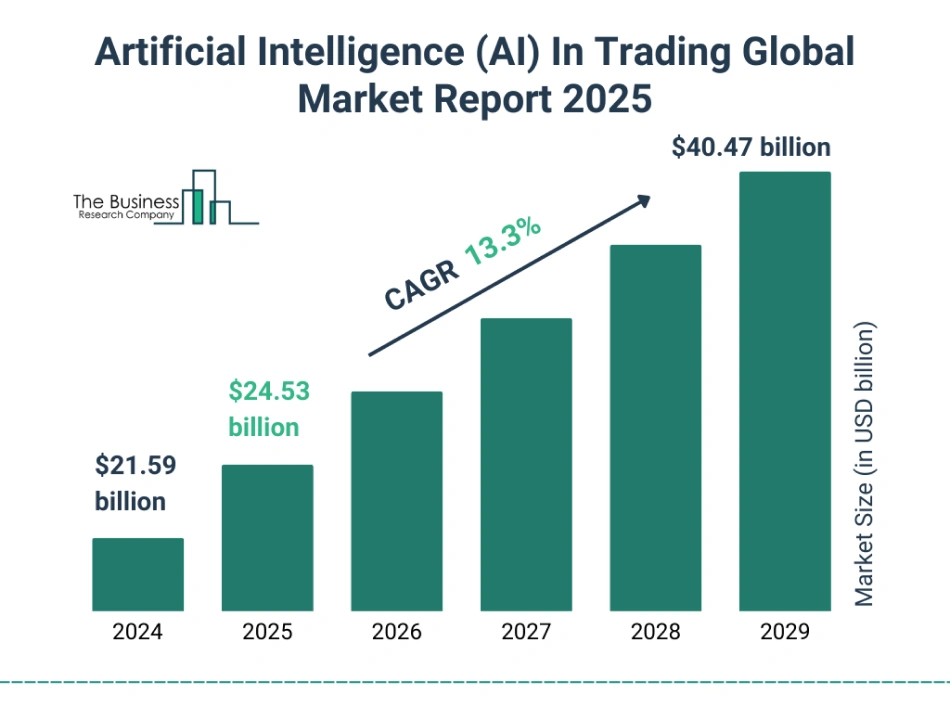
By investing in an AI Stock Trading Agent, you position yourself or your organization at the forefront of an increasingly automated and optimized trading landscape. The combination of speed, accuracy, and adaptive intelligence delivers real competitive impact.
Partner with our expert AI developers to turn your stock trading vision into a scalable solution.
Book a Free Consultation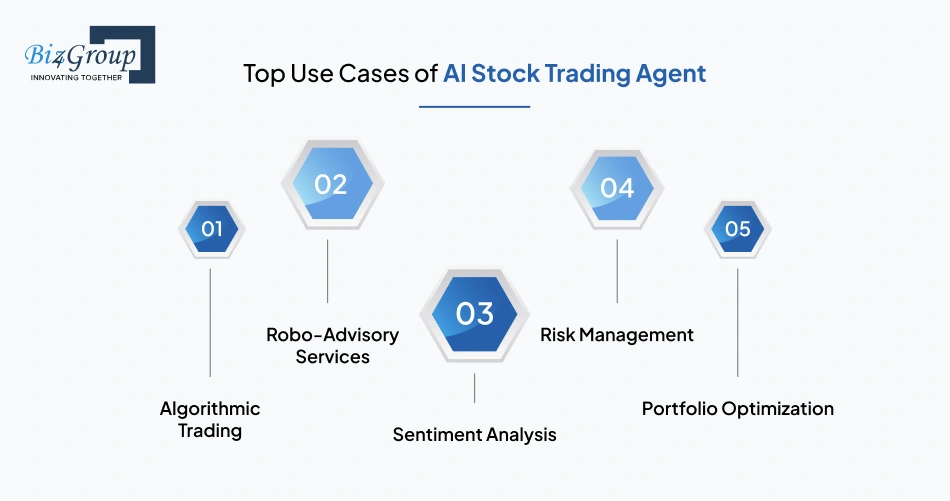
An AI Stock Trading Agent is not a one-dimensional tool. Its adaptability allows it to be applied in several practical ways, benefiting both individual traders and large financial institutions. Below are the top use cases with real-world examples that highlight how these agents operate in practice.
Algorithmic trading involves executing trades based on predefined rules and strategies at lightning speed. AI agents enhance this process by continuously refining these strategies with real-time data.
Example: A hedge fund might use an AI Stock Trading Agent to detect arbitrage opportunities, such as differences in the price of the same stock listed on two exchanges. The AI can instantly execute trades to profit from this discrepancy—something a human trader would never spot quickly enough.
Robo-advisors use AI to provide personalized investment advice and portfolio management to clients. These services are accessible to retail investors who may not have access to traditional financial advisors.
Example: An investor with $10,000 to start investing can connect with an AI-powered robo-advisor. The system analyzes their risk appetite, investment goals, and time horizon. Based on this data, it creates a customized portfolio and automatically rebalances it over time to maximize returns. Companies like Betterment and Wealthfront have already popularized this model.
Markets are influenced not only by financial metrics but also by public sentiment. AI trading agents can scan news articles, financial blogs, and even social media posts to gauge the mood around specific stocks or sectors.
Example: Suppose rumors spread on Twitter about a major tech company facing regulatory scrutiny. An AI agent picks up the negative sentiment early, predicts a drop in the company’s stock price, and sells off positions before the wider market reacts. This provides a clear competitive edge.
AI trading systems are designed to anticipate and mitigate potential losses. By analyzing historical data and monitoring current conditions, they can predict downturns and suggest defensive strategies.
Example: During a market downturn triggered by unexpected economic news, an AI Stock Trading Agent might detect rising volatility and automatically shift part of a portfolio into safer assets such as government bonds or cash equivalents. This automated risk adjustment helps protect capital.
Portfolio optimization focuses on balancing different asset classes to achieve the best possible returns with controlled risk. AI trading agents use advanced models to constantly monitor and rebalance investments.
Example: An investor holding a portfolio of tech, healthcare, and energy stocks might see one sector suddenly underperform. The AI agent detects this shift, reduces exposure to the weak sector, and reallocates funds into stronger-performing industries. This ensures that the overall portfolio remains aligned with the investor’s risk-return goals.
Each of these applications demonstrates the versatility of AI in trading. From executing trades faster than any human to providing everyday investors with tailored advice, the AI Stock Trading Agent is reshaping how financial decisions are made.
By adopting these use cases, both individuals and institutions can enhance efficiency, reduce risks, and maximize profitability in competitive markets.
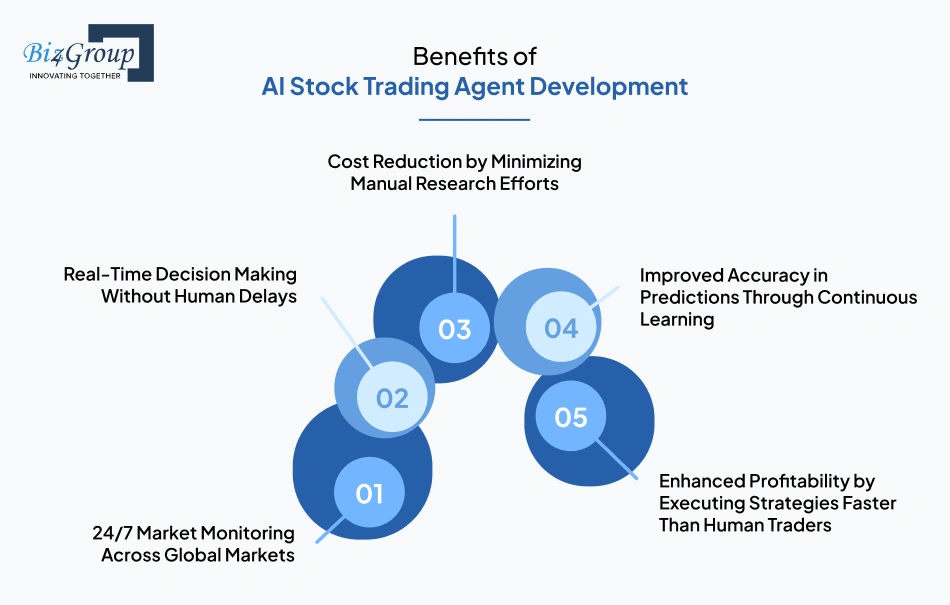
Artificial intelligence is changing how financial markets are analyzed and traded. By applying it to trading systems, businesses and investors gain tools that improve efficiency, accuracy, and profitability.
The following benefits show why adopting this technology has become a strategic choice for modern traders.
Financial markets operate around the clock. Human traders cannot continuously monitor activities in New York, London, and Tokyo simultaneously, but an AI agent can. By scanning multiple markets 24/7, it ensures no opportunity is missed. For instance, if significant economic news emerges in Asia during U.S. nighttime hours, the AI system can immediately adjust positions, eliminating the time lag caused by human limitations.
Additional Advantages:
Stock prices can change within milliseconds. Traditional decision-making processes often suffer from analysis delays or emotional hesitation. AI agents, however, make real-time decisions based on pre-trained models and current data. If a sudden price spike occurs due to a positive earnings announcement, the agent can capitalize instantly before the broader market reacts, securing maximum gains.
Additional Advantages:
Manual stock analysis requires significant time and financial expertise. Research teams often spend hours combing through financial reports, news articles, and technical charts. AI trading agents reduce these costs by automating data collection and analysis. This efficiency not only saves on research expenses but also enables traders to focus on strategy and growth rather than repetitive tasks.
Additional Advantages:
Unlike static trading models, AI agents continuously refine their strategies. After every trade, they evaluate outcomes and feed the results back into their learning system. Over time, this feedback loop improves prediction accuracy, allowing the AI to adapt to new market conditions. For example, during sudden market volatility, an AI system that has learned from past events can make more accurate decisions compared to rigid, rule-based systems.
Additional Advantages:
Speed is critical in modern trading. Even a one-second delay can determine whether a trade results in profit or loss. AI systems execute orders instantly through brokerage APIs, ensuring optimal timing. Consider high-frequency trading scenarios where profits are measured in fractions of a cent per share—AI agents thrive in such environments by processing massive volumes of trades at speeds humans cannot match.
Additional Advantages:
This section highlights how the building of AI Stock Trading Agent Development directly impacts efficiency, accuracy, and profit potential.
By incorporating AI in Stock Trading Agent Development, traders and businesses can gain long-term advantages that go beyond traditional methods, ultimately ensuring a smarter and more sustainable trading approach.
When building AI stock trading agent systems, success relies on combining intelligence with usability. The features of AI stock trading agent must not only support speed and accuracy but also adapt to user needs and ensure security.
Below is a table of key elements to prioritize while creating AI stock trading agent for long-term success.
| Feature | Explanation |
|---|---|
|
Real-Time Data Integration |
Connects with multiple financial data providers to deliver accurate and updated market insights at all times. |
|
Market Sentiment Analysis |
Scans news, blogs, and social media to gauge public opinion and influence trading strategies accordingly. |
|
Predictive Analytics Engine |
Uses machine learning models to forecast price movements and market trends with high precision. |
|
Automated Trade Execution |
Places buy and sell orders instantly through brokerage APIs, eliminating manual delays. |
|
Risk Management Tools |
Includes features like stop-loss, take-profit, and risk thresholds to safeguard investments. |
|
Backtesting Module |
Allows strategies to be tested against historical data to evaluate effectiveness before live deployment. |
|
Portfolio Optimization |
Adjusts asset allocations automatically to maximize returns while minimizing risks. |
|
Multi-Asset Support |
Enables trading across stocks, forex, commodities, and cryptocurrencies under one platform. |
|
Adaptive Learning |
Continuously improves predictions by learning from past trades and evolving market conditions. |
|
Customizable Trading Strategies |
Lets users define or modify trading logic to match individual preferences and goals. |
|
High-Frequency Trading Capability |
Executes a large number of trades per second to capitalize on micro-opportunities. |
|
User-Friendly Dashboard |
Provides clear visualizations, performance metrics, and strategy monitoring tools for easy use. |
|
Security and Compliance |
Ensures data encryption, secure APIs, and adherence to financial regulations to build user trust. |
|
Cloud Integration |
Supports scalability and reliability by leveraging cloud platforms for data storage and processing. |
|
Alerts and Notifications |
Sends real-time updates via email, SMS, or app notifications about trades, risks, or portfolio changes. |
By implementing these top features, your AI Stock Trading Agent can deliver smarter trading decisions while staying secure, scalable, and easy to manage.
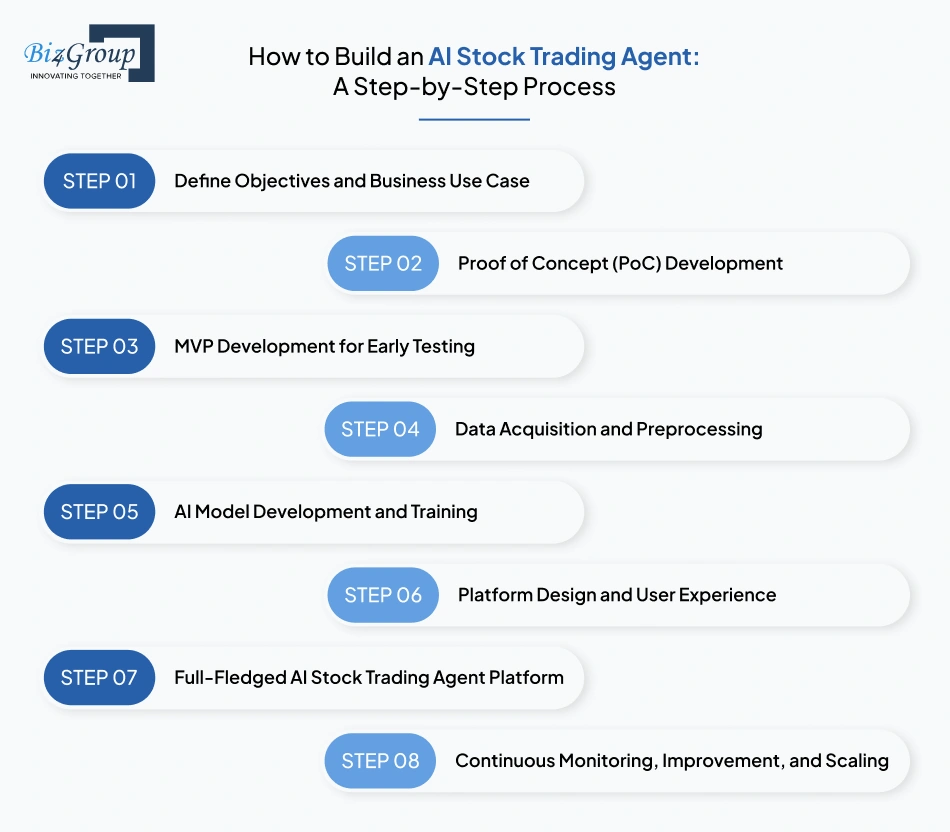
Creating a reliable and profitable AI Stock Trading Agent requires structured planning, robust execution, and continuous refinement. From initial idea validation to building a full-scale platform, every phase has a clear purpose. Below are the essential steps that guide this journey.
The starting point is to clearly identify what you want the AI Stock Trading Agent to achieve. Are you aiming for high-frequency trading, long-term portfolio management, or sentiment-driven strategies? Each goal defines the data sources, algorithms, and tools you will use.
Why this matters: A well-defined use case prevents wasted resources and ensures your system is built with a clear focus. Without clarity, the project risks becoming overly complex and misaligned with business needs.
Before heavy investment, it is vital to test the idea with a PoC. This involves building a small-scale prototype that demonstrates how the AI can analyze data and make simple trading decisions.
Why this matters: A PoC provides early validation. It shows whether the technology is viable and whether investors or stakeholders should support the project. It also highlights technical challenges before moving into larger development stages.
The next step is MVP development, where you create a minimum viable product with essential features like real-time data collection, trade execution, and basic analytics. Partnering with an experienced UI/UX design company ensures the platform is intuitive, even at this early stage.
Why this matters: The MVP allows real traders to test the system in controlled conditions. Their feedback ensures that the core functions—data accuracy, decision-making speed, and usability—are validated before scaling. This step saves time and money by avoiding major redesigns later.
Also Read: Top MVP Development Companies in USA
AI systems thrive on high-quality data. At this stage, you collect and prepare data from sources such as stock exchanges, news APIs, and financial reports. Cleaning and structuring this data ensures accurate predictions.
Why this matters: Poor data quality leads to poor results. By focusing on preprocessing, you ensure the foundation of the trading agent is reliable, which directly impacts its performance in live markets.
This step involves designing AI models that forecast stock prices, detect trends, and manage risks. Techniques such as deep learning, reinforcement learning, and natural language processing can be integrated. At this point, AI integration is critical, ensuring the models are connected seamlessly with other components like APIs and dashboards.
Why this matters: The aim here is to create the intelligence that powers the trading agent. Strong model training determines how accurate and profitable the system will be in real-world scenarios.
Beyond functionality, the trading agent must be usable. Collaborating with a top UI/UX design companies ensures the dashboard is easy to navigate, provides clear performance insights, and supports both novice and advanced traders.
Why this matters: The best AI system is useless if traders cannot interact with it effectively. Good design builds trust and increases adoption among users. It is not just about how the platform works but also how it feels to the trader.
Once the MVP and models have been validated, you move to creating a full-scale platform. This version includes advanced features such as sentiment analysis, multi-asset support, risk management, and portfolio optimization. Collaborating with the top AI agent development companies in USA can accelerate this stage, especially if scalability and compliance with financial regulations are required.
Why this matters: The goal is to build a production-ready system capable of handling real-world trading volumes, integrating multiple data sources, and offering robust security. This is where your idea becomes a commercial-grade AI solution.
AI systems do not remain static. After launch, the agent must be continuously monitored, retrained with new data, and updated to adapt to changing market conditions. Feedback loops help the AI evolve and improve its accuracy and profitability.
Why this matters: Markets are dynamic, and so must be your trading agent. Continuous monitoring ensures the system remains competitive and sustainable, while scaling allows it to handle larger user bases and more assets over time.
Building an AI Stock Trading Agent is not a one-time task but a progressive journey. From PoC to MVP development to a full-fledged platform, each stage plays a vital role in transforming an idea into a reliable trading solution that meets the demands of today’s financial markets.
Also Read: A Step-by-Step Guide to AI Trading Agent Development
Discover how a custom AI Stock Trading Agent can optimize your strategies and maximize profits.
Get Started TodayThe cost of AI Stock Trading Agent development can vary widely depending on scope, features, and technology choices. On average, budgets range from $20,000 to over $200,000, but this is only a starting point.
The actual investment depends on the complexity of your platform, the size of your development team, and the level of customization required. Businesses often underestimate these factors, which is why a clear breakdown is critical when planning to create an AI stock trading agent.
Below are the primary cost drivers and how they influence your project budget:
Why it matters: Core development defines the intelligence of your system. More sophisticated models, advanced analytics, and higher data volume handling increase costs but deliver stronger performance.
Cost range: $5,000–$30,000.
Here’s an overview table of factors affecting cost for AI Stock Trading Agent Development.
| Cost Factor | Estimated Range | Notes |
|---|---|---|
|
Core Development & Engineering |
$20,000 – $150,000+ |
Depends on system complexity and team expertise. |
|
Data Sources & API Integrations |
$5,000 – $30,000 |
Premium data feeds significantly raise costs. |
|
UI/UX Design & Front-End |
$10,000 – $40,000 |
Cost varies based on dashboard complexity. |
|
Cloud Hosting & Infrastructure |
$2,000 – $20,000+ (annual) |
Higher for global, high-frequency systems. |
|
Security & Compliance |
$10,000 – $25,000 |
Includes KYC/AML compliance, encryption, and audits. |
|
Maintenance & Updates |
15–20% of total cost annually |
Covers AI retraining, bug fixes, and upgrades. |
While the cost to make an AI Stock Trading Agent can be significant, the long-term value it delivers through automation, efficiency, and profitability makes it a strategic investment for traders and fintech businesses alike.
Also Read: AI Agent Development Cost: Factors and Examples
Selecting the right technology stack is a crucial step in developing a scalable and efficient AI Stock Trading Agent. The stack must balance performance, security, and adaptability to ensure smooth integration and long-term reliability. Below is a breakdown of the essential components categorized by their role in the system.
| Parameter | Recommended Tools | Explanation |
|---|---|---|
|
Frontend (UI/UX Layer) |
React, Angular, Vue.js |
Provides responsive dashboards, live charts, and smooth user interactions so traders can monitor strategies and performance in real time. |
|
Backend (Server & APIs) |
Orchestrates data pipelines, model serving, and broker API calls while enforcing security and authentication. |
|
|
Databases |
PostgreSQL, MongoDB, Redis |
Stores historical market data, trades, and user configs; Redis accelerates caching for low-latency reads. |
|
AI & Machine Learning Frameworks |
TensorFlow, PyTorch, Scikit-learn |
Powers prediction, reinforcement learning, and feature engineering with tooling for training and inference. |
|
Data Sources & Market APIs |
Yahoo Finance API, Alpha Vantage, Bloomberg, Interactive Brokers API, Alpaca |
Supplies real-time and historical data plus execution endpoints, which are essential for accurate signals and timely orders. |
|
Cloud Hosting & Infrastructure |
AWS, Google Cloud, Microsoft Azure |
Delivers elastic compute for training, managed databases, and secure networking for production workloads. |
|
Security Tools |
OAuth 2.0, SSL/TLS, End-to-End Encryption |
Protects credentials and sensitive financial data while meeting regulatory expectations. |
|
DevOps & CI/CD Tools |
Docker, Kubernetes, Jenkins, GitHub Actions |
Automates builds, testing, deployments, and rollbacks to keep releases reliable and frequent. |
|
Visualization & Analytics |
D3.js, Tableau, Power BI |
Creates performance reports and strategy diagnostics with interactive charts and KPI tracking. |
|
Monitoring & Observability |
Prometheus, Grafana, ELK/Opensearch |
Tracks latency, fill rates, drawdowns, and model drift; alerts teams before issues impact trading. |
|
Feature Store & Data Ops |
Feast, Airflow, dbt |
Manages feature definitions, reproducible pipelines, and versioned transformations for consistent modeling. |
|
Model Serving |
TorchServe, TensorFlow Serving, FastAPI |
Exposes models behind low-latency endpoints with A/B and shadow testing options. |
|
Event Streaming |
Kafka, Pub/Sub, Kinesis |
Streams ticks, orders, and signals to keep services loosely coupled and real time. |
|
Testing & Backtesting |
Zipline, Backtrader, pytest |
Validates strategies against historical data and secures code quality with unit and integration tests. |
|
Compliance & Audit |
Vault, Cloud KMS, Audit Logs |
Manages secrets, encryption keys, and immutable logs for audits and regulatory reporting. |
|
Recommended Tech Stack Example |
React frontend + FastAPI backend + PostgreSQL + PyTorch models + Interactive Brokers/Alpaca APIs + AWS EKS (Kubernetes) + Docker + Prometheus/Grafana |
A pragmatic end-to-end setup: modern UI, Python services for speed of iteration, reliable SQL storage, scalable model training/serving, broker integrations for execution, container orchestration, and full observability for production. |
Use this matrix as a blueprint to assemble a stack that fits your goals, then tailor each layer to your latency, scale, and compliance needs.
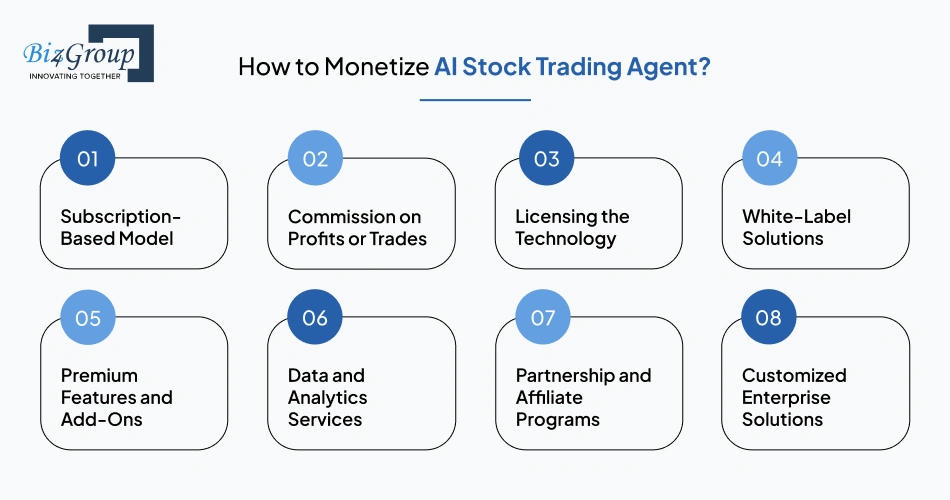
Developing an AI Stock Trading Agent is not just about building a smart trading system; it is also about creating sustainable revenue streams.
One of the most straightforward strategies is offering your AI Stock Trading Agent as a subscription service. Users pay a recurring monthly or yearly fee to access trading features such as automated trade execution, real-time analytics, and portfolio optimization.
Example: A fintech company may charge $49/month for basic access and $199/month for premium access with advanced features like multi-asset support and sentiment analysis.
Why it works: Subscription models generate predictable recurring revenue while scaling easily with user growth.
Once the platform is live and functional, monetization strategies ensure profitability, scalability, and long-term growth. Below are some of the most effective ways to monetize your trading agent.
Another popular option is charging a performance-based commission. The agent automatically deducts a percentage of profits or a small fee per trade executed through the platform.
Example: If the AI agent earns $1,000 in profits for a trader, the system may deduct a 10% commission ($100). Alternatively, it may charge $0.01 per executed trade.
Why it works: Users see the value clearly—fees are tied to actual performance, making the pricing model transparent and results-driven.
If you are targeting institutions rather than retail traders, licensing your AI trading technology to brokerage firms, hedge funds, or banks can be highly lucrative. Businesses pay a licensing fee to integrate your trading engine into their existing systems.
Example: A hedge fund may license your predictive trading algorithm to enhance its high-frequency trading desk, paying annual fees for usage rights.
Why it works: Licensing creates high-value deals and positions your AI system as a proprietary technology asset.
A white-label model allows you to sell your AI Stock Trading Agent under another company’s brand. Fintech startups or brokers looking for fast market entry can rebrand and offer your solution to their clients.
Example: A startup offering robo-advisory services could launch your AI agent under its own branding, while you earn revenue from licensing or setup fees.
Why it works: This expands your reach without requiring you to market directly to end users.
Offer a freemium model where basic functionality is free or low-cost, while advanced tools require payment. Premium features may include advanced predictive analytics, sentiment monitoring, or high-frequency trading capabilities.
Example: Free users can access delayed market data, while premium users gain access to real-time feeds and AI-driven predictive alerts.
Why it works: Freemium models attract a wide user base quickly, converting a percentage into paying customers.
Your AI Stock Trading Agent will generate large volumes of market data and performance insights. These datasets can be anonymized and monetized by selling them to financial institutions, research firms, or investment managers.
Example: Providing aggregated trading trend reports to institutional clients at a premium price.
Why it works: Data has high value in financial markets. By turning your platform’s intelligence into packaged insights, you create an additional revenue stream.
You can establish partnerships with brokers or fintech platforms, earning referral fees or revenue shares when users sign up through your AI agent.
Example: A trader who opens a brokerage account through your platform generates affiliate revenue for you from the broker.
Why it works: This strategy reduces customer acquisition costs while opening up new income channels.
Beyond retail users, larger firms may need tailored trading systems built on your AI engine. Offering enterprise-level customization for risk management, compliance, or proprietary strategies can command premium pricing.
Example: A financial institution may pay $250,000+ for a fully customized AI trading system aligned with its internal requirements.
Why it works: Enterprise clients bring higher revenue per deal and create long-term partnerships.
To make profit from your AI Stock Trading Agent, you need to monetize it effectively. By following the above business models, whether through subscriptions, commissions, licensing, or premium add-ons you can turn your trading solution into a sustainable and profitable venture.
Also Read: From Idea to Income: How to Monetize AI App Effectively
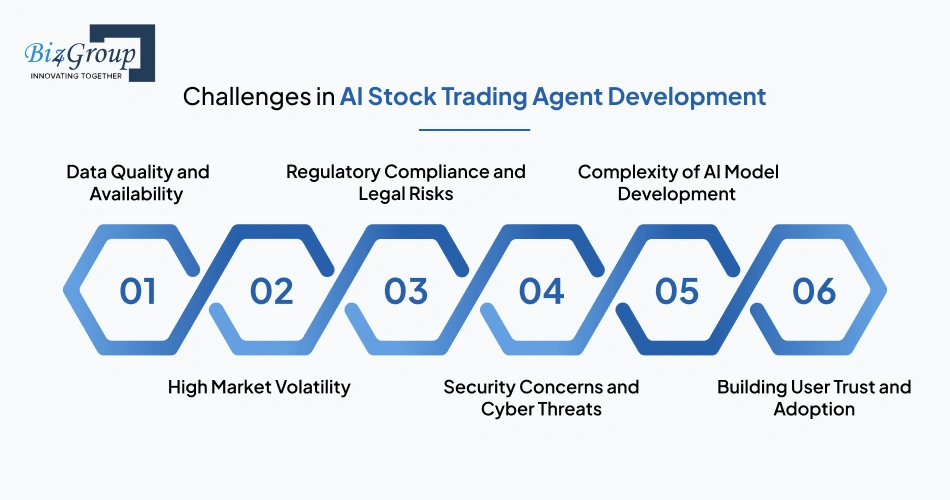
While the potential of AI Stock Trading Agents is enormous, the development journey is not without challenges. Building a reliable, compliant, and profitable solution requires tackling both technical and business hurdles. Below are the major obstacles and practical approaches to solving them.
Challenge:
AI models are only as good as the data they are trained on. Inconsistent, incomplete, or low-quality financial data can lead to inaccurate predictions and poor trading outcomes. Real-time access to clean and structured market data is another major challenge due to costs and integration complexities.
Solution:
Challenge:
Stock markets are unpredictable, and sudden fluctuations caused by global events, political changes, or economic crises can disrupt even the most sophisticated models. AI systems may fail to generalize when exposed to conditions not seen during training.
Solution:
Challenge:
Trading agent must adhere to strict financial regulations such as KYC (Know Your Customer), AML (Anti-Money Laundering), and region-specific securities laws. Failure to comply can result in heavy fines, license revocations, or reputational damage.
Solution:
Challenge:
AI stock trading agents handle sensitive financial data and direct market transactions, making them prime targets for hackers. Risks include data breaches, unauthorized trades, and system manipulation.
Solution:
Challenge:
Building, training, and maintaining AI models for trading requires specialized expertise in both finance and machine learning. Misaligned models can either underperform or create false signals that lead to losses.
Solution:
Challenge:
Traders may hesitate to rely on AI for financial decisions, fearing system errors, loss of control, or lack of transparency. Without trust, adoption will remain low, regardless of how powerful the platform is.
Solution:
Creating an AI Stock Trading Agent comes with significant challenges, but each can be overcome with the right strategies. From securing clean data to ensuring compliance and building user trust, addressing these issues head-on transforms obstacles into opportunities for innovation and growth.
Partnering with the right AI agent development company can transform your vision into a high-performing, compliant trading system. Biz4Group offers deep expertise in AI developers, fintech solutions, and enterprise-level customizations—making them a standout partner for development of AI Stock Trading Agent initiatives.
Biz4Group boasts a team of skilled AI developers experienced in building scalable, intelligent systems. Their track record includes predictive modeling and real-time trading platforms—ensuring your solution is not only thoughtfully engineered but also optimized for performance and profitability.
Unlike off-the-shelf offerings, Biz4Group specializes in AI agent development for stock trading that aligns precisely with your strategic goals—whether it's high-frequency trading, robo-advisory, or portfolio diversification. Their custom approach ensures your agent reflects your unique requirements and competitive edge.
Financial systems must navigate regulations like KYC, AML, and data privacy laws. Biz4Group builds with compliance baked in, safeguarding sensitive data and reinforcing trust in your platform.
From proof of concept (PoC) and MVP development to full-scale deployment, Biz4Group handles every phase with transparency and precision. This seamless approach cuts project complexity, minimizes downtime, and ensures efficient execution.
Markets evolve. So should your AI stock trading agent. Biz4Group provides ongoing monitoring, model retraining, and system tuning to keep your platform ahead of market dynamics—long after deployment.
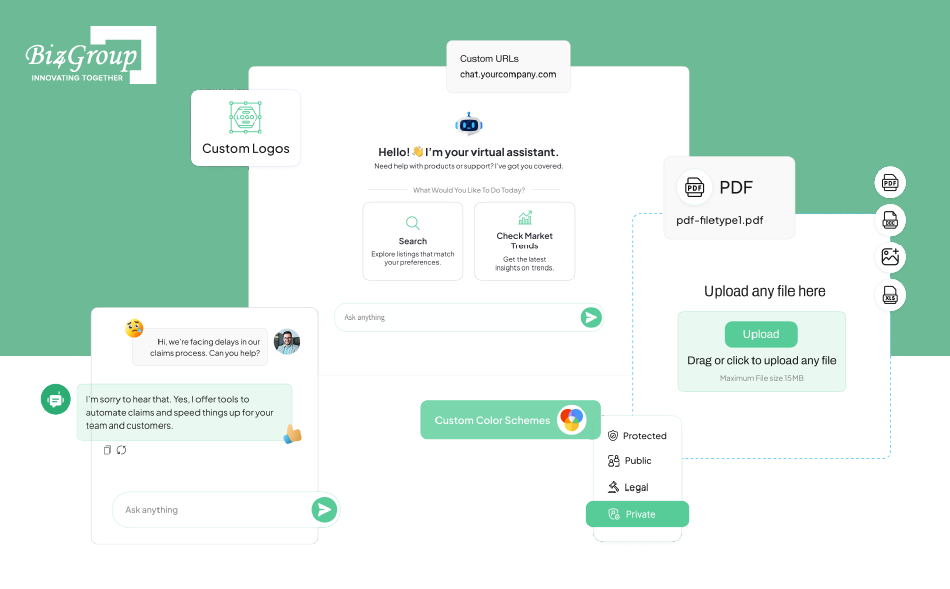
While not directly in stock trading, this project showcases Biz4Group’s breadth in custom enterprise AI agent development:
This project demonstrates Biz4Group’s ability to build robust, secure, and integrable AI agents—capabilities that readily extend to sophisticated trading systems.
When you engage Biz4Group for your AI agent development for stock trading, you're immersed in a partnership that blends expert AI developers, compliance diligence, and deep customization. Backed by real enterprise successes, Biz4Group turns the development of AI Stock Trading Agent into a strategic, growth-focused journey.
Whether it’s an MVP or a full-fledged AI trading system, we deliver solutions tailored to your business goals.
Schedule an AppointmentFrom above, the path to building an AI Stock Trading Agent shows how technology and strategy come together to reshape modern finance. It is not only about creating automation but about unlocking new levels of accuracy, efficiency, and profitability. While challenges like compliance, data quality, and volatility exist, they can be overcome with the right partner who understands both AI and trading domains.
Choosing a reliable AI agent development company ensures that your vision is supported by expert AI developers, scalable infrastructure, and secure practices. Whether your goal is to design an MVP, integrate advanced analytics, or launch a full enterprise-grade platform, the right approach makes success achievable.
Book an appointment with Biz4Group today to explore tailored AI agent development for stock trading.
AI Stock Trading Agents are designed for both. Institutions use them for large-scale trading and risk management, while individual traders can leverage them for automation, portfolio optimization, and data-driven decision-making without needing deep technical expertise.
The timeline depends on scope. A proof of concept (PoC) may take 4–6 weeks, MVP development can take 3–4 months, and a full-fledged enterprise platform may require 6–12 months with continuous updates.
No AI system can guarantee profits. They improve accuracy, reduce human error, and optimize decision-making, but market volatility and unforeseen global events still carry inherent risks.
Development requires expertise in machine learning, data science, financial analysis, API integration, and secure software engineering. Partnering with a professional AI agent development company bridges these skill gaps.
Robust security measures such as end-to-end encryption, multi-factor authentication, compliance with KYC/AML, and regular penetration testing protect sensitive financial data from threats.
Biz4Group combines experienced AI developers, fintech consultants, compliance-ready systems, and proven success in multiple AI projects. They provide end-to-end solutions that are secure, scalable, and tailored to your goals.
with Biz4Group today!
Our website require some cookies to function properly. Read our privacy policy to know more.